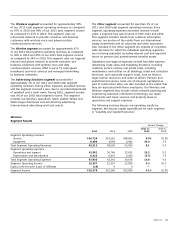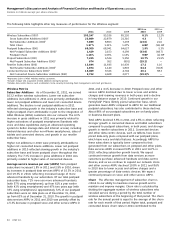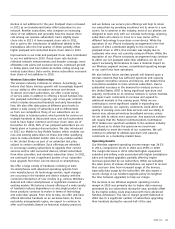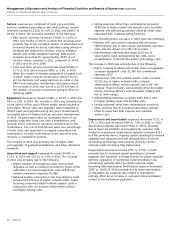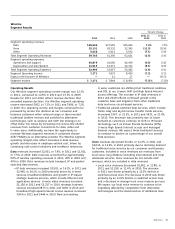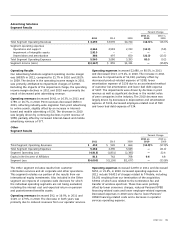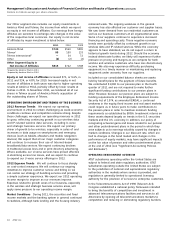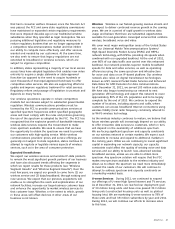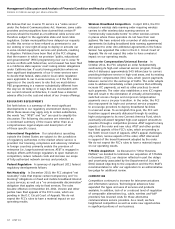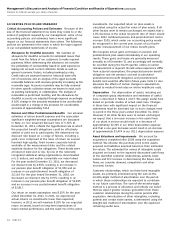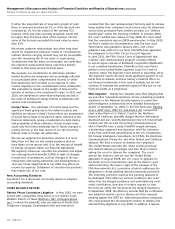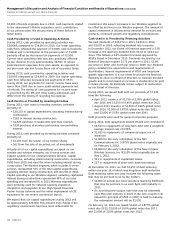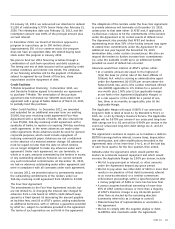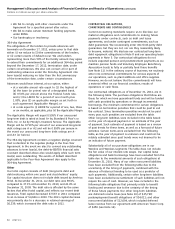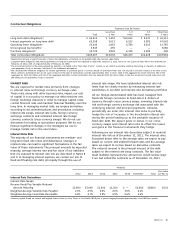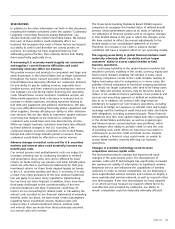AT&T Wireless 2011 Annual Report Download - page 45
Download and view the complete annual report
Please find page 45 of the 2011 AT&T Wireless annual report below. You can navigate through the pages in the report by either clicking on the pages listed below, or by using the keyword search tool below to find specific information within the annual report.
AT&T Inc. 43
Our wireline subsidiaries (excluding rural carrier affiliates)
operate under state-specific forms of regulation for retail
services that was either legislatively enacted or authorized
by the appropriate state regulatory commission. Most states
deregulate the competitive services; impose price caps for
some services where the prices for these services are not
tied to the cost of providing the services or to rate-of-return
requirements; or adopt a regulatory framework that
incorporates deregulation and price caps. Some states may
impose minimum customer service standards with required
payments if we fail to meet the standards.
We continue to lose access lines due to competitors
(e.g., wireless, cable and VoIP providers) who can provide
comparable services at lower prices because they are
not subject to traditional telephone industry regulation
(or the extent of regulation is in dispute), utilize different
technologies, or promote a different business model (such
as advertising based) and consequently have lower cost
structures. In response to these competitive pressures, for
several years we have utilized a bundling strategy that
rewards customers who consolidate their services (e.g., local
and long-distance telephone, high-speed Internet, wireless
and video) with us. We continue to focus on bundling wireline
and wireless services, including combined packages of
minutes and video service through our U-verse service and
our relationships with satellite television providers. We will
continue to develop innovative products that capitalize on
our IP-based network.
Additionally, we provide local, domestic intrastate and
interstate, international wholesale networking capacity, and
switched services to other service providers, primarily large
Internet Service Providers using the largest class of nationwide
Internet networks (Internet backbone), wireless carriers,
Competitive Local Exchange Carriers, regional phone ILECs,
cable companies and systems integrators. These services
are subject to additional competitive pressures from the
development of new technologies and the increased
availability of domestic and international transmission capacity.
The introduction of new products and service offerings and
increasing satellite, wireless, fiber-optic and cable transmission
capacity for services similar to those provided by us continue
to provide competitive pressures. We face a number of
international competitors, including Orange Business Services,
British Telecom, SingTel and Verizon Communications Inc.,
as well as competition from a number of large systems
integrators, such as HP Enterprise Services.
Advertising Solutions
Our Advertising Solutions subsidiaries face competition
from approximately 100 publishers of printed directories in
their operating areas. Competition also exists from other
advertising media, including newspapers, radio, television and
direct-mail providers, as well as many forms of Internet-based
and mobile advertising. Through our wholly-owned subsidiary,
YELLOWPAGES.COM LLC, we compete with other providers
of Internet-based advertising and local search.
Wireless
We face substantial and increasing competition in all
aspects of our wireless business. Under current FCC rules,
multiple licensees, including six or more PCS licensees, two
cellular licensees and one or more enhanced specialized
mobile radio licenses may operate in each of our service
areas, which results in the potential presence of multiple
competitors. Our competitors include companies such as
Verizon Wireless, Sprint Nextel Corp., T-Mobile, Metro PCS
and Cricket, a larger number of regional providers of cellular,
PCS and other wireless communications services and resellers
of those services. More than 97% of the U.S. population lives
in areas with at least three mobile telephone operators,
and 90% of the population lives in areas with at least
five competing carriers.
The FCC may develop rules to auction or otherwise make
available additional spectrum to the wireless industry. The FCC
has yet to develop the rules under which this spectrum might
be available. We may experience significant competition
from companies that provide similar services using other
communications technologies and services. While some of
these technologies and services are now operational, others
are being developed or may be developed. We compete for
customers based principally on service/device offerings,
price, call quality, coverage area and customer service.
Wireline
Our wireline subsidiaries expect continued competitive
pressure in 2012 from multiple providers, including wireless,
cable and other VoIP providers, interexchange carriers and
resellers. In addition, economic pressures are forcing
customers to terminate their traditional local wireline service
and use competitive wireless and Internet-based services,
intensifying a pre-existing trend toward wireless and Internet
use. At this time, we are unable to quantify the effect of
competition on the industry as a whole or financially on this
segment. However, we expect both losses of revenue share
in local service and gains resulting from business initiatives,
especially in the area of bundling of products and services,
including wireless and video, large-business data services
and broadband. In most markets, we compete with large
cable companies, such as Comcast Corporation, Cox
Communications Inc. and Time Warner Cable Inc., for local,
high-speed Internet and video services customers and other
smaller telecommunications companies for both long-distance
and local services customers.
Our wireline subsidiaries generally remain subject to
regulation for wholesale services by state regulatory
commissions for intrastate services and by the FCC for
interstate services. Under the Telecom Act, companies seeking
to interconnect to our wireline subsidiaries’ networks and
exchange local calls enter into interconnection agreements
with us. Any unresolved issues in negotiating those
agreements are subject to arbitration before the appropriate
state commission. These agreements (whether fully agreed-
upon or arbitrated) are then subject to review and approval
by the appropriate state commission.


